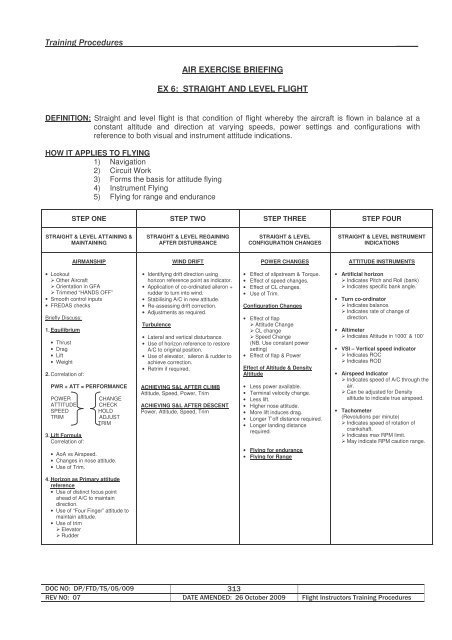Flight Instructors Training Procedures _revised AIC_x
Flight Instructors Training Procedures _revised AIC_x
Flight Instructors Training Procedures _revised AIC_x
You also want an ePaper? Increase the reach of your titles
YUMPU automatically turns print PDFs into web optimized ePapers that Google loves.
AIR EXERCISE BRIEFING<br />
EX 6: STRAIGHT AND LEVEL FLIGHT<br />
DEFINITION: Straight and level flight is that condition of flight whereby the aircraft is flown in balance at a<br />
constant altitude and direction at varying speeds, power settings and configurations with<br />
reference to both visual and instrument attitude indications.<br />
HOW IT APPLIES TO FLYING<br />
1) Navigation<br />
2) Circuit Work<br />
3) Forms the basis for attitude flying<br />
4) Instrument Flying<br />
5) Flying for range and endurance<br />
STEP ONE STEP TWO STEP THREE STEP FOUR<br />
STRAIGHT & LEVEL ATTAINING &<br />
MAINTAINING<br />
AIRMANSHIP<br />
• Lookout<br />
Other Aircraft<br />
Orientation in GFA<br />
Trimmed “HANDS OFF”<br />
• Smooth control inputs<br />
• FREDAS checks<br />
Briefly Discuss:<br />
1. Equilibrium<br />
• Thrust<br />
• Drag<br />
• Lift<br />
• Weight<br />
2. Correlation of:<br />
PWR + ATT = PERFORMANCE<br />
POWER CHANGE<br />
ATTITUDE CHECK<br />
SPEED HOLD<br />
TRIM ADJUST<br />
TRIM<br />
3. Lift Formula<br />
Correlation of:<br />
• AoA vs Airspeed.<br />
• Changes in nose attitude.<br />
• Use of Trim.<br />
4. Horizon as Primary attitude<br />
reference<br />
• Use of distinct focus point<br />
ahead of A/C to maintain<br />
direction.<br />
• Use of “Four Finger” attitude to<br />
maintain altitude.<br />
• Use of trim<br />
Elevator<br />
Rudder<br />
STRAIGHT & LEVEL REGAINING<br />
AFTER DISTURBANCE<br />
WIND DRIFT<br />
• Identifying drift direction using<br />
horizon reference point as indicator.<br />
• Application of co-ordinated aileron +<br />
rudder to turn into wind.<br />
• Stabilising A/C in new attitude.<br />
• Re-assessing drift correction.<br />
• Adjustments as required.<br />
Turbulence<br />
• Lateral and vertical disturbance.<br />
• Use of horizon reference to restore<br />
A/C to original position.<br />
• Use of elevator, aileron & rudder to<br />
achieve correction.<br />
• Retrim if required.<br />
ACHIEVING S&L AFTER CLIMB<br />
Attitude, Speed, Power, Trim<br />
ACHIEVING S&L AFTER DESCENT<br />
Power, Attitude, Speed, Trim<br />
*)*<br />
STRAIGHT & LEVEL<br />
CONFIGURATION CHANGES<br />
POWER CHANGES<br />
• Effect of slipstream & Torque.<br />
• Effect of speed changes.<br />
• Effect of CL changes.<br />
• Use of Trim.<br />
Configuration Changes<br />
• Effect of flap<br />
Attitude Change<br />
CL change<br />
Speed Change<br />
(NB. Use constant power<br />
setting)<br />
• Effect of flap & Power<br />
Effect of Altitude & Density<br />
Altitude<br />
• Less power available.<br />
• Terminal velocity change.<br />
• Less lift.<br />
• Higher nose attitude.<br />
• More lift induces drag.<br />
• Longer T’off distance required.<br />
• Longer landing distance<br />
required.<br />
• Flying for endurance<br />
• Flying for Range<br />
STRAIGHT & LEVEL INSTRUMENT<br />
INDICATIONS<br />
ATTITUDE INSTRUMENTS<br />
• Artificial horizon<br />
Indicates Pitch and Roll (bank)<br />
Indicates specific bank angle.<br />
• Turn co-ordinator<br />
Indicates balance.<br />
Indicates rate of change of<br />
direction.<br />
• Altimeter<br />
Indicates Altitude in 1000’ & 100’<br />
• VSI – Vertical speed indicator<br />
Indicates ROC<br />
Indicates ROD<br />
• Airspeed Indicator<br />
Indicates speed of A/C through the<br />
air.<br />
Can be adjusted for Density<br />
altitude to indicate true airspeed.<br />
• Tachometer<br />
(Revolutions per minute)<br />
Indicates speed of rotation of<br />
crankshaft.<br />
Indicates max RPM limit.<br />
May indicate RPM caution range.<br />
!"#$ # &"" '$ #













